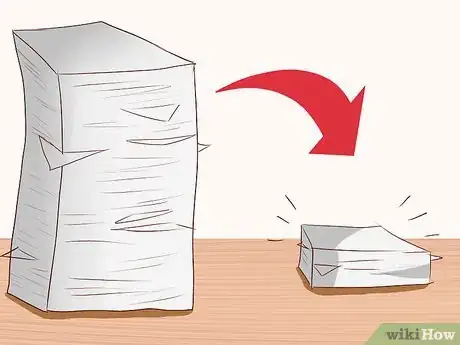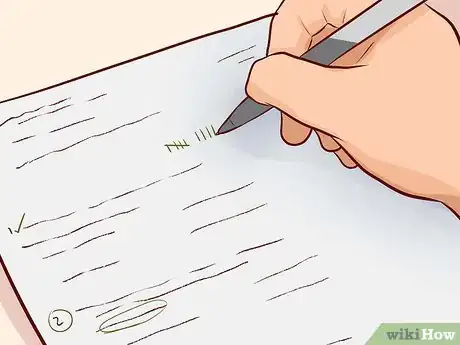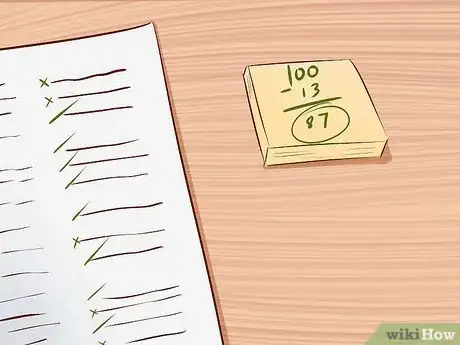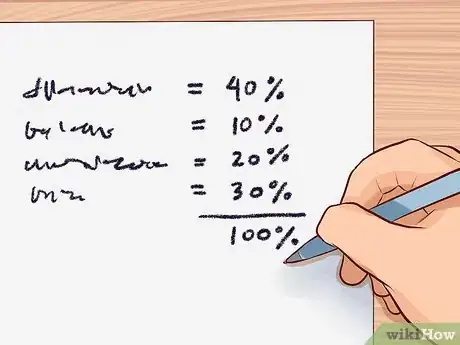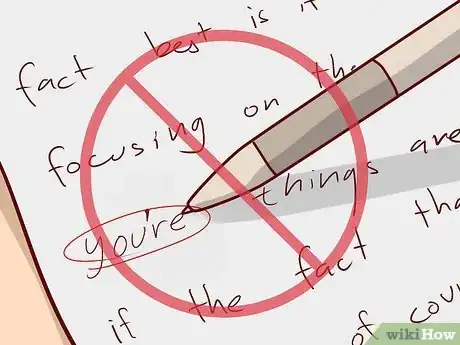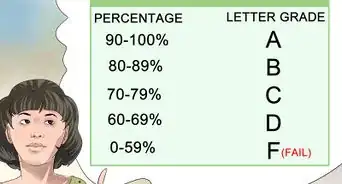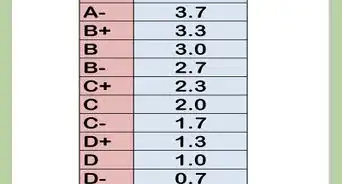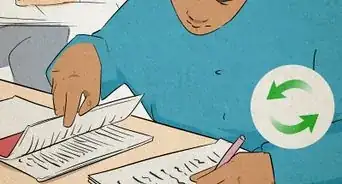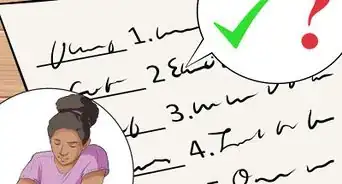wikiHow is a “wiki,” similar to Wikipedia, which means that many of our articles are co-written by multiple authors. To create this article, volunteer authors worked to edit and improve it over time.
This article has been viewed 22,444 times.
Learn more...
Teachers like grading tests about as much as students like taking them. If you've got a big pile you've got to get through, you can learn to get through it as quickly and comfortably as possible. Whether you've got multiple choice, short answer, or essay tests, you can learn how to grade them the right way.
Steps
Grading Basics
-
1Set a deadline. After your students take a test, tell them a specific day that you'll have the grading finished. This will keep them from bugging you each day about when they can expect their grades, and it will give you a deadline so you won't be able to procrastinate.
- Try to think some about how much work you've got to do in the next couple of days, and how much time you'll be able to devote to grading. Can you do half the tests tonight and half tomorrow? Or will you need more time?
- Some tests will take a lot longer than other tests to grade, but even multiple choice tests will take a while if you've got a couple hundred of them.
-
2Only grade a few at a time. Don't try to grade all of the tests at once, especially if you're teaching several classes and have dozens of students. Instead, put aside time each day when you're not busy for grading some of the tests.
- Pick a 1-2 hour block the first day and grade as many as you can. Then, calculate how much longer you'll need to finish all the tests you've got to grade, and schedule the time accordingly.[1]
- Alternatively, some teachers prefer to grade all the tests at once and get it over with, especially if the tests are multiple choice.
Advertisement -
3Get comfortable. All teachers have different routines, but it helps to establish one for grading. Are you a stay-late at school and grade at your desk grader? Or a grade on the couch with a glass of wine grader? Both good options. Whatever feels most comfortable and natural for you is fine. Settle in for a good grading session.
- While some teachers require total silence and concentration to do work, others will prefer to have a show going in the background, or some music playing. Multiple choice tests are easy to grade with a game on in the background, but essay tests usually require more attention.
- Make sure that you have everything that you need. Answer keys, your grade-book, and an organized pile of graded tests and need-to-be-graded tests are essential. Also, a stiff drink of your choice is sometimes a good idea.
-
4Use blue or green ink. Lots of teachers favor the authority of the red pen, but many an innocent student has been traumatized by the visual shock of a bled-on paper. There's good reason to use ink, to make sure your marks will be tamper-proof, but unless there's a good reason, use a neutral color pen to grade with.
-
5Mark incorrect answers wrong. Most teachers will use a small line or an "X" through the number corresponding to the incorrect answer. Make it small and never cross out something the student has written in an essay test. Circle or underline a part of a response that you want to highlight, right or wrong. Read the next section for more information about calculating grades.
- Some teachers like to tally the cumulative score at the bottom of each page to make the addition easier at the end. Use tally marks at the top of each page for answers marked wrong, so you'll be able to check at a glance.[2]
- Double-check your marks when you tabulate. If you make a mistake while you're grading, you can always change the grade later, but it tends to look a little bad if you make a silly little counting mistake while you're grading.
-
6Return the tests at the beginning of class. While some teachers like to wait until the end of class to return tests, it's better to return them at the beginning so that students aren't antsy about their grade on the tests, and you can take the beginning of class to answer any questions they have about the test along with going over it.
- Don't post grades publicly. A student's grade is a student's grade. There's little reason to position it against the other grades in the class.
-
7Be available for questions. Make yourself available for questions, complaints, and general confusion after a test, especially if the test was an essay test or a short answer test, which might have more room for debate.
- Some teachers like to take 10-15 minutes at the beginning of class to go over a test, discussing the grades and common mistakes. This can be a good way to cut down on one-on-one conversations, but you still need to be available for them, preferably after class.
- Come up with a contingency plan for mistakes. If lots of students all made the same mistake, you need to ask yourself who was at fault. A test is just as much an evaluation of your ability to teach as it is their ability to learn.
Calculating Grades
-
1Add up the number of wrong answers. After you've graded the test, count up how many answers the student got wrong. Subtract this number from the number of questions on the test to find out how many answers the student got right.
- If you're grading an essay or multiple-choice test, add up the number of missed points, or points marked off.
-
2Calculate the grade percentage. To get the percentage, divide the number of answers the student got correct by the number of answers possible, which should result in a decimal answer. To get the percentage, move the decimal point two places to the right.
- If you want to know more about different strategies for calculating grades, read this article.
-
3Assign a letter grade, if necessary. Some teachers like to use letter grades, while others prefer just letting the numbers and the percentages do the talking. The pros of a letter grade is that it gives the student a concrete measure of their ability on the test, but it can be unnecessarily rigid. 15/20 sounds pretty good, but a "C" is often thought of as being a bad grade.
- Consider using words instead of letters, like, "Outstanding," or "Good" or "Poor" to stand in for the letters.
-
4Record the score. Tally up the score and mark it clearly on the last page of the test. It's good to make students flip through the test, to actually look at it and see what they did right and what they did wrong throughout, rather than just seeing a grade on the front and throwing it in the garbage.
- Keep a record of the students' grades on the tests on an Excel spreadsheet or in a gradebook that you keep. This way, if you lose the tests at any point, you'll still have a record for the end of the semester.
- Never return tests that you haven't recorded somewhere. If the only record of the grade that a student got is on the paper you handed back, calculating their grade at the end of the semester is going to be rough.
-
5Use an online grade calculator, if necessary. If you're an English teacher who hates math, there are a variety of online grade calculators that will tabulate the grade for your quickly, without having to do any number-crunching yourself.
Grading Short-Answer and Essay Tests
-
1Use a rubric. A rubric is a description of the assumptions that you're making as the evaluator of the test. In other words, a rubric is like an agreement between the teacher and the student about what constitutes good work and a correct response. These are very important when you're grading essay tests and short-answer tests, which can seem more subjective than multiple-choice tests, which have clear right and wrong answers.
- Often, rubrics are broken down into points. If you're grading an essay, how many points will be awarded for style? How many for thesis? Main points?
- What will you be looking for in the essay that the students are to write? How will you choose to evaluate it? What must be there for the essay to be complete? What must be there for the essay to be A-quality work?
- Write up the rubric and share it with your students before they take the essay test. Knowing what you'll be grading for will be an excellent way to study.
-
2Write comments. If there's nothing to mark wrong on an essay test, what are you supposed to do? Respond to the student's ideas, encourage creative thinking, and comment on their writing in the margins. Comments give the student something more concrete to hold onto, and helps them know why they got the grade they got.
- Be specific. If you find a confusing or unclear sentence, don't write, "?" Instead, write, "This seems interesting, but it's unclear. What do you mean by 'society'?"
- The worst thing to do with an essay test is to slap a grade on it and hand it back with nothing else written out. Writing comments takes time, but it's important.
- Don't comment on too many different types of things. Comment on three major things the student could improve on, or remember for next time.[3]
-
3Establish a firm rule for partial points. Short-answer tests are tough to grade when it comes to tallying up the score. What if a student correctly identifies three of the four Beatles, but misses the fourth? Is the answer wrong?
- Usually, short-answer questions should be worth more than on point each, to allow for partials. Still, it can be difficult when you're grading from test to test and will involve some judgment calls.
- To make it as objective as possible, make your questions as concrete as possible.
-
4Don't grade for usage errors, unless it's part of the lesson. If you have students write in class without the opportunity to revise their writing, it's not good policy to take off too many points for misspellings, comma errors, or other smaller usage issues. Grade their ideas and their creativity, not how well they held up in writing under pressure.[4]
- If you're an English teacher, essay or short-answer tests may be given over particular grammar or usage topics, in which case you should single those issues out for evaluation.
- In some cases, handwriting and other usage things might inhibit your ability to grade the test at all. You need to consider ahead of time whether or not you'll accept a test you can't read. Will you have them re-write?
-
5Look for vocabulary and detail. Some students are masters of vagueness when it comes to essay tests. Don't get swept up in their long reams of nothing. Look for specific understanding and clear discussions of the topics or issues at hand in the essay test, and look for clear answers to the question that you presented.
- Make it clear when you hand out the test and coach the students that digressions should be avoided on the test. It's better to turn in a short essay that answers the question clearly than one that's long enough, but half-done.
-
6Go slowly. Essay tests are a lot more difficult and subjective when it comes to grading than multiple choice tests, which go pretty quickly. Slow down and grade the tests in smaller chunks to avoid getting burned out and making mistakes that you might have to change later.
- You should consider each essay alone, against the prompt and the rubric. Don't compare essays to each other, except to make sure that you're grading consistently. If one essay earned an "A," and another very similar essay didn't, make sure you're not changing your criteria inadvertently.
- Try to de-stress before you sit down to grade. If you're stressed out, frustrated, or angry, it may show on the comments and evaluations you make on the tests.
Warnings
- Don't procrastinate. Just like it's bad for a student to procrastinate on a major essay, it's bad for you to procrastinate on your grading, too.⧼thumbs_response⧽
- Don't fall asleep. Have an alarm that goes off every once in a while if you're starting to fall asleep.⧼thumbs_response⧽
- Don't stay up all night grading tests. You won't be fully alert, and if you're not fully alert, it may show in your comments on the tests. It will also make you more likely to make a mistake in grading a test.⧼thumbs_response⧽
References
- ↑ http://thecornerstoneforteachers.com/free-resources/planning-and-assessment/grading-made-simple
- ↑ http://cft.vanderbilt.edu/guides-sub-pages/grading-student-work/
- ↑ http://www.usf.edu/atle/documents/handout-grading-writing-assignments.pdf
- ↑ http://inside.mines.edu/UserFiles/File/LAIS/WAC/EssayExams.pdf
About This Article
To grade a test, start by adding up the total number of wrong answers. Then, subtract that number from the number of questions on the test to find out how many questions were answered correctly. Next, divide that number by the total number of questions. Finally, move the decimal point in the number you get 2 points to the right to find the grade percentage. To learn how to grade short answer and essay tests, scroll down!

